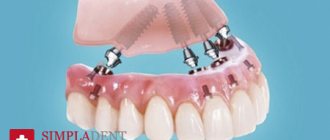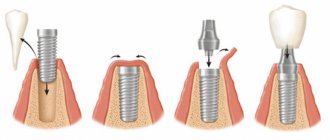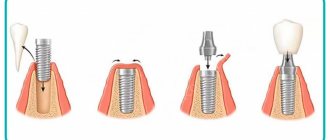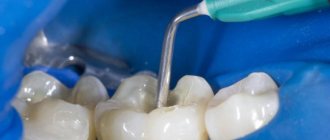The absence of even one tooth can cause both physical and psychological discomfort. That is why the simultaneous implantation procedure is very popular among patients. In a maximum of two visits, the patient solves his problem and gets a beautiful and healthy smile. As with any operation, dental implantation has its contraindications. Below we will look at all the features of the procedure and tell you for whom this method is suitable and who should resort to other procedures.
Single-stage implantation: what is it?
Instant prosthetics involves installing an implant immediately after removing a damaged tooth. This method is considered the most gentle and is recommended by doctors for those patients who do not have serious contraindications.
A thorough examination of the oral cavity should be done in advance, and if sanitation is indicated, the doctor will perform it before surgery.
The history of the express method of dental implantation
Back in the middle of the last century, Swedish professor Brenemark discovered the amazing property of titanium to organically fuse with bone tissue. This is how titanium implants appeared.
As a rule, implantation occurs in two stages: first, a titanium base of a new tooth is installed, which takes 4-6 months to grow into the bone tissue. And then a zirconium, composite or metal-ceramic prosthesis is attached.
During the period of ingrowth of the titanium implant, the hole remains empty or closed with a plastic insert. However, this type of implantation is not acceptable for all patients. This is how new, revolutionary protocols emerged that allow the installation of new teeth in one stage: All-on-4, All-on-6, basal implantation.
The main advantage of one-stage implantation is that after installing the titanium base, a temporary prosthesis is immediately placed on it, which is replaced with a permanent one after the implant has completely grown in.
This express method is often used for targeted restoration of damaged teeth in the smile area, because... In one visit, you can remove tooth fragments and immediately install a temporary crown.
Stages of treatment
The duration of one-stage implantation is about 4-6 months. Restoration of bone tissue after tooth extraction is not required; bone tissue augmentation as a separate procedure is also not performed. Therefore, after installing the implants, a temporary prosthesis is immediately fixed, and after a few months, when the implants and bone tissue have completely fused, a permanent dental crown is installed.
Galina Vladimirovna, 57 years old
“I had my natural teeth removed and implants were immediately placed. Within a week my smile was back. I really like the way I look and the way I talk. My diction hasn’t changed, I’m comfortable. I am very pleased and grateful to the doctors!”
- we give SMILES, HEALTH and new LIFE
- smile and enjoy every day
- start CHEWING immediately
- forget about the unpleasant smell and pain
- complete the entire treatment in a WEEK
watch a video with the patient
Preparation for implantation (from 2 days to 2-3 weeks)
When a tooth is removed and an implant is installed at once, sometimes there is very little time left to prepare for treatment, since most often teeth that are in very poor condition have to be removed. However, implantologists pay great attention to this stage, since it is necessary to conduct a thorough examination of the patient’s oral cavity and body, to exclude possible contraindications that could cause rejection of the structure.
Preparation for immediate implantation is absolutely standard and includes taking a series of blood tests, taking an X-ray or panoramic photo of the jaw, as well as dental treatment and removal of deposits. If there are acute problems with the body, we can refer the patient to an appointment with a highly specialized doctor to clarify the diagnosis, assess the state of health and carry out appropriate treatment
Installation of implants and bone grafting (1-2 hours)
Installation of an implant with simultaneous tooth extraction is carried out in a fairly simplified form: additional tissue incisions and bone drilling are not required to form a bed for the implant. The tooth is removed from the socket as carefully as possible, with minimal trauma to the bone tissue. Next, the cavity is thoroughly sanitized. If necessary, an x-ray is prescribed so that you can make sure that the cavity is empty and there are no pieces of instruments or parts of the tooth left inside it. Next, a dental implant is fixed in the hole, and the space around it is sprinkled with artificial bone tissue. The gums around the implant are sutured.
Temporary prosthetics (3-6 months)
Depending on the initial situation, both one-piece and two-piece implants can be used for simultaneous implantation. Both of them can be instantly loaded with a temporary prosthesis.
Three types of structures can be used as temporary dentures (they are selected based on the quality of bone tissue, the degree of primary fixation of the dental implant and the number of missing teeth):
- removable immediate denture (for front and side teeth),
- lightweight plastic crown (only for front teeth with single restorations),
- acrylic prosthesis with plastic crowns (with complete edentia).
A resin crown is created that is slightly shorter in length than the adjacent teeth in the row. This allows you to significantly reduce the load on the prosthesis, and hence the implant itself. At the same time, the appearance of the smile is maintained at the highest level. From the point of view of further aesthetics, a single crown is a more preferable option for single restorations, since it allows you to shape the position of the gums.
It is important! Installation of a single crown is possible only on single-rooted teeth, which do not bear much pressure, and they mostly perform aesthetic functions - these are incisors and canines. If you chew food with the restored tooth, the implant simply will not take root, since it will shift due to the load.
In case of complete edentia, when it is necessary to restore the entire dentition, several implants are installed at once. If there are teeth that need to be removed, some of the implants can be fixed into their sockets. In this case, a fixed prosthesis with a metal base, acrylic base and plastic crowns is fixed on top. It firmly connects all installed implants, which prevents them from moving. Read more about immediate loading methods >>>
Permanent prosthetics (1-2 weeks)
Permanent prosthetics are the final stage of treatment. It can be started only after the doctor is convinced that the implants have completely fused with the bone tissue - measurements are carried out with special devices and x-rays.
The temporary crown is removed, impressions are taken - the data is transferred to a dental laboratory, where an individual prosthesis is created. The dental technician must take into account the position of neighboring and antagonist teeth located on the opposite jaw. The manufacturing process takes about 1-2 weeks.
Metal-ceramics or zirconium can be chosen as materials for permanent dentures - these crowns are more aesthetic, stronger and more durable.
Advantages of the method
- shortened treatment times,
- no bone grafting required
- instant restoration of aesthetics,
- no bone tissue augmentation is carried out,
- lower cost of treatment,
- The service life of installed implants is more than 20 years.
Disadvantages of the method
The only disadvantage of one-step implantation is that it is not always possible to carry out it. You need to prepare for treatment: assess the condition of the body, exclude contraindications, select an implant model depending on the volume and quality of bone tissue. But the removal of your own tooth quite often has to be done urgently, which does not make it possible to conduct a full examination and understand whether it is possible to install an implant at the same time.
Indications for implantation
All medical procedures are carried out solely according to indications. Experts recommend that patients resort to simultaneous implantation for the following problems:
- restoration of the front row of teeth;
- trauma with soft tissue damage;
- severe tooth deformation;
- tooth extraction due to gum disease;
- urgent tooth restoration.
List of mandatory requirements for the procedure
During the initial examination, the doctor will assess the condition of the oral cavity for the possibility of carrying out immediate implantation. The procedure is performed only if the following requirements are met:
- Suitable volume of bone tissue.
- There is no inflammation in the area of the tooth root;
- Bone tissue without atrophic changes;
- The area of the extracted tooth without obvious tissue deformations;
- The gums are in satisfactory condition;
- The interradicular septum must be preserved.
How much does express implantation cost at the Lotus Dent dental clinic?
The price of one-stage implantation depends on a number of factors: the type of technique, brand of implant, the need for additional manipulations (bone grafting or gum grafting). Doctors will be able to name the exact amount only after diagnosis.
If you contact our clinic, you can be sure that the treatment will be carried out by professionals in their field. Our doctors strive to create the optimal treatment plan for each patient, taking into account his clinical case and financial capabilities. You can make an appointment at the Lotus Dent dental clinic by calling the phone number listed on the website.
Contraindications to one-stage dental surgery
Medical intervention should not be carried out if the patient has contraindications for this, which are divided into the following types:
- absolute (operation excluded);
- local (depending on the condition of the jaw);
- relative (the decision about the operation is made by the doctor).
The doctor eliminates all risks at the first examination and carefully examines the patient’s medical history. During the conversation, clarifying questions are asked to provide a complete picture of past and chronic diseases.
Let's consider absolute contraindications, in which simultaneous implantation is completely excluded:
- Allergy to the administration of anesthesia.
- Various blood diseases.
- All degrees of diabetes.
- Weak immunity.
- The bone tissue has undergone atrophic changes.
- Connective tissue does not recover quickly enough.
- Chewing muscles are in strong tone.
- Tuberculosis.
- The endocrine system has pathologies.
- Venereal diseases.
- Tumors of a malignant nature.
- Presence of mental illness.
- HIV infection.
Relative contraindications
These contraindications are only an obstacle to immediate implantation. The doctor decides how risky the procedure is.
- The gums are subject to inflammation.
- Some teeth require sanitation.
- The bite has pathological disorders.
- Presence of arthrosis changes.
- Tobacco use.
- Arthritis.
- Alcohol and drug addictions.
- Any trimester of pregnancy.
- The oral cavity is in unsatisfactory hygienic condition.
- Marginal periodontitis.
Local contraindications
- There is not enough bone tissue.
- The jaw arch is not dense enough and its structure is damaged.
- The short distance to the sinus makes the operation labor-intensive.
Temporary factors under which the procedure is possible
The doctor gives permission to perform the operation after the patient resolves the issue with the following factors:
- Chemotherapy.
- The period of rehabilitation after a somatic illness;
- Exacerbation of chronic and other diseases;
- Pregnancy.
After a course of chemotherapy, you should wait at least a year and only after this period can you have surgery. Let's not hide it - there is always a risk of implant rejection and the doctor will not give you a 100% guarantee, but the result is quite justified: the artificial tooth will look like a real one.
Despite the rather long list of contraindications, some of them can be corrected and treated. In addition, the procedure can also be performed by people of retirement age, which makes this procedure accessible and popular among patients of dental clinics around the world.
Advantages of one-stage dental implantation
Here we will look at the benefits of the procedure and talk about why patients choose it and doctors recommend it:
- the procedure takes place in a short time - a maximum of two days;
- the health of neighboring teeth is preserved;
- less manipulation than with classical implantation;
- gum formation begins immediately after the installation of the abutment and crown;
- pronounced aesthetic effect - the artificial tooth looks like a natural one.
It is obvious that one-stage implantation is significantly superior to traditional (classical) implantation, because it is not only more affordable, but also less traumatic. You don’t have to go to the clinic for a long time, just 2 days and your smile will be beautiful and natural.
Fast planned installation of implants using navigation templates
The use of templates during implantation allows you to reduce the time for implantation. The video below describes the installation of mini-implants, but the approach is similar to classical implantation.
What are surgical guides? These are plastic structures that are attached to the site where the operation will be performed. Guide holes are pre-drilled on them; special cutters with depth limiters are used to prepare the hole for installing implants.
A few days before the operation, the patient is examined and a three-dimensional study is carried out, the data obtained is transferred to a computer program that creates a model for installing artificial tooth roots. In the program, the doctor determines the optimal location for installing the implant, calculates the angle and depth of insertion. Afterwards, an implantation project is developed, based on which an implantation surgical template is printed on a 3D printer.
Using this template, the surgeon spends no more than 10 minutes to install one implant, while the bone tissue is prepared with minimal trauma. The risks of complications are almost completely eliminated. Read more about the technology here.
Preparation for implantation
Simultaneous dental implantation is a complex procedure that requires preliminary diagnosis of the condition of the oral cavity for dental caries and the presence of various inflammatory diseases. Implantation can be started only after complete treatment. To obtain reliable information about the height or level of the bone tissue into which the implant is planned to be implanted, it is necessary to take an X-ray of the teeth. If it turns out that there is not enough bone tissue to perform the operation, the doctor will first augment it.
Description of the technique
Single-stage implantation is a technology, the essence of which is that the implant is installed immediately in place of the extracted tooth. The hole formed after tooth extraction is ideal for implanting a titanium rod. Thanks to this, there is no need for an additional incision in the gum and the formation of a bed for the implant. The technology is called differently - instant, instant and express implantation.
Thanks to one-step dental implantation, two complex procedures are combined into one. Only one anesthesia will be required, but during one operation not only will the destroyed tooth be removed, but a new one will be installed to replace it.
Local anesthesia is recommended, but in some cases (for example, when the patient is too worried), the use of general sedation is permitted. The manipulations will be carried out during medical sleep.
Before performing implantation, sanitation of the oral cavity is necessary - the doctor will make prescriptions in a particular case. You may need professional cleaning, treatment of caries or inflammation of the gums.
Factors that contribute to the success of the operation are:
- Removal is as gentle as possible when there is no branched, non-standardly located root system.
- The jawbone retained its elasticity and volume.
- There are no infectious lesions. Otherwise, preliminary therapeutic treatment is necessary.
- The presence of a “thick” gum biotype will facilitate implantation.
All issues are discussed between the doctor and the patient during consultation, decisions are made based on specific circumstances.
If necessary, dentists of other specializations - therapists or orthodontists - are invited to clarify some points. Prices for one-stage dental implantation are final, including the cost of diagnostics, anesthesia, and surgical intervention. The main component is payment for the implantation system.
Stages of one-stage implantation
Fear of the dentist is a fairly common problem, despite the fact that modern methods and materials can significantly reduce pain during treatment. The worries will not be so strong if you initially know all the stages of the procedure and see that there is nothing to fear:
- Before the operation, a consultation is always carried out with a detailed diagnosis of the patient’s condition.
- A CT scan of the jaw is performed.
- A decision is made on the advisability of the operation.
- The doctor makes a 3D simulation of the operation.
- The patient is given local anesthesia.
- Complete removal of the deformed tooth is performed;
- Using a special drill, a hole is drilled in the bone tissue of the jaw.
- The hole is expanded to the optimal diameter with a special tool.
- The implant is implanted through the root socket: the element is screwed into the jaw.
- Next, the abutment is fixed to the implant.
- A temporary composite crown is installed.
A temporary crown should be worn until the implant is completely healed. On average no more than six months. Then a permanent crown is installed from durable, abrasion-resistant materials: metal ceramics or zirconium dioxide.
Comparison of techniques
| Classical | One-stage | One-step | |
| Implant installation method | Flap - with peeling of the gum to access the bone | Transgingivally - through a puncture of soft and bone tissues | In the socket of an extracted tooth |
| Type of temporary prosthetics | A removable denture that is fixed to adjacent teeth | Temporary lightweight crown on an implant with bite relief | Removable denture or temporary crown on an implant |
| Duration of temporary prosthetics | 2-6 months before implant implantation | 2-6 months before implant implantation | 2-6 months before implant implantation |
| Formation of the gingival contour | Before permanent prosthetics | Not carried out | Depends on the type of prosthetics |
| Type of permanent prosthetics | Zirconium dioxide crown | Zirconium dioxide crown | Zirconium dioxide crown |
All three methods are painless, are performed under local anesthesia or sedation, and the patient does not feel any discomfort.
The same preparation is carried out, there is no difference in the required examinations. To identify contraindications, the following is carried out:
- taking anamnesis;
- inspection;
- CT scan.
The contraindications are the same:
- uncompensated diabetes mellitus;
- oncology;
- osteoporosis;
- bleeding disorders;
- tuberculosis;
- mental disorders.
But patients are more interested in the ability to quickly recover a lost tooth completely. According to this criterion, two methods differ - classical and one-stage. The one-stage method after removal is continued according to one of the protocols - with delayed or immediate loading.
Recovery postoperative period
After the operation, the recovery period begins, the person has solved his problem and now there is an implant instead of a damaged tooth. How to care for it and what should you be wary of on the doctor’s recommendation until the tooth finally begins to feel like your own?
For the first few days, the patient will experience slight swelling, which will cause discomfort. This is normal because surgery was performed. It is worth avoiding excessive chewing loads during this period and carefully monitoring oral hygiene using special antiseptics. During the first month, the discomfort goes away, and the patient forgets that he has an implant installed.
Stages
Express implantation has several stages:
- Preparation and planning of the operation . At this stage, the surgeon conducts a thorough examination of the patient to determine the condition of the bone tissue and identify possible contraindications. If necessary, gum and periodontal diseases are treated during this period of time. In accordance with the data obtained, the implant and orthodontic structure are individually selected, and the location for optimal implantation is determined. This period can take up to a month.
- Bone tissue augmentation . One of the disadvantages of express implantation is the impossibility of performing it with small volumes of bone, since the elements are quite large. Therefore, in some cases there is a need for surgery to artificially increase bone tissue. This process can take up to six months.
- Installation of implants and prosthetics. Each element is fixed by piercing through all gum tissue and bone. In this case, the abutment is an integral component of the implant and a lightweight metal-plastic prosthesis can be immediately fixed onto it, which can immediately perform all the necessary dental functions. All manipulations take several hours.
Review statistics among specialists and patients
The one-stage prosthetics method began to be used in Russia relatively recently, while in Europe such services have been provided for several years. Analyzing world statistics, you can see that this method has collected a large number of positive reviews and enjoys well-deserved trust among both doctors and patients. The problem of a missing tooth is solved in record time.
Single-stage implantation also perfectly solves the aesthetic component of the problem: there are patients who do not like the look of their own teeth. They delay visiting the dentist and go without a tooth for a long time, not deciding on implantation. In addition, many people think that implantation takes a long time and are unable to find a place for the procedure due to their busy work schedule. However, the procedure is performed quickly and the installed tooth will look aesthetically pleasing and natural. Negative reviews can only be found regarding dissatisfaction with the price: the procedure is not budget-friendly and not everyone can afford it.
Price
The technique of one-stage implantation requires the use of high-quality materials and modern equipment. In addition, the highly qualified implantologist is very important. The total cost of the procedure consists of consumables, the level of the doctor and the clinic. If the clinic has its own dental laboratory, the cost of the implant will be significantly lower. The average price for a turnkey installation is 45 thousand rubles. The service life of implants reaches 25 years, provided that high-quality materials are selected and the procedure protocol is strictly followed. The best implants are those made in Sweden, Israel and the USA.











